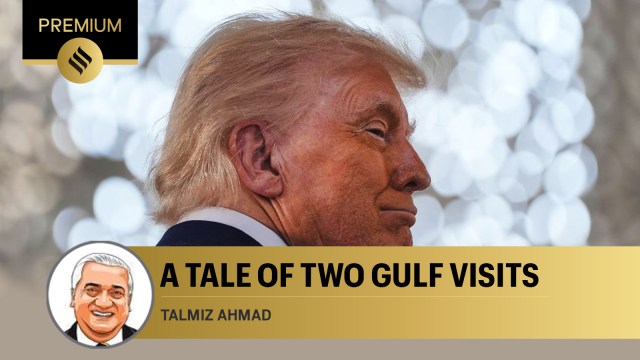
US President Donald Trump’s sojourn in West Asia this month could not have been more different from his visit in May 2017. As now, the kingdom had been his first foreign destination eight years ago (besides the quick visit to Rome for the Pope’s funeral), but then the President’s approach to the region had been deeply influenced by his political allies, the evangelical Christians and the Israel lobby.
He had viewed the domains of his Arab hosts as sources of extremism and violence and had later showered limitless gifts upon Israel and its prime minister, Benjamin Netanyahu: He moved the US embassy from Tel Aviv to Jerusalem, backed the expansion of Israeli settlements in the West Bank, and promoted the “deal of the century” on the Palestine issue, which was heavily skewed in Israel’s favour.
None of this was apparent during the present tour; Israel, in fact, was largely missing from the President’s agenda. In the run-up to the visit, the US had finalised agreements with the Houthis and Hamas without Israel’s involvement, while continuing talks with Iran on the nuclear issue. During the visit, Trump discovered a newfound empathy for his Arab hosts, their faith and their culture, in sharp contrast to the deep hostility he had exhibited towards Islam and its adherents in his first term. He described Saudi Crown Prince Mohammed bin Salman as “incredible” and noted that the crown prince and the Emir of Qatar, Sheikh Tamim Al Thani, were “tall, handsome guys that happen to be very smart”. Syrian President Ahmed al-Sharaa was to him a “young, attractive guy. Tough guy. Very strong past. Fighter.”
While during his visit in 2017 he had spoken of the “crisis of Islamic extremism” and the need to eliminate the “wave of fanatical violence”, now, during his visit to the Grand Mosque in Abu Dhabi, Trump spoke of the region’s “amazing culture” and separately praised the Gulf leaders for modernising the region and driving out “the forces of terrorism and extremism”. He blamed US military interventions, promoted by neocons, for causing great damage to the region.
Throughout his visit to Riyadh, Doha and Abu Dhabi on May 13-16, Trump focused almost entirely on deals with his host countries, being backed in this regard by a strong delegation of top American corporate leaders representing energy, infrastructure, logistics, defence, data processing and hi-tech entities such as Nvidia, OpenAI, BlackRock, Amazon, Google, Oracle, Uber, Palantir and Boeing, among others.
It is the multi-billion-dollar contracts that captured the headlines during the visit: In Saudi Arabia, a $142-billion agreement was announced for the kingdom to buy “state-of-the-art war-fighting equipment and services” from a dozen US military companies. Trump and the Saudi Crown Prince signed the Strategic Economic Partnership Document setting out trade and investment deals valued at $600 billion in the areas of energy, mining and hi-tech, including supply of semiconductors and setting up of data centres.
The deals announced with Qatar amounted to $244 billion, including $96 billion for the purchase of 210 Boeing jets for Qatar Airways. A deal of $38 billion covered military investments, including air defence and maritime security. In Abu Dhabi, the UAE agreed to an investment framework, including AI infrastructure, semiconductors, energy and industry, valued at $1.4 trillion.
Taking a holistic view of the Trump visit, it is obvious that the Gulf states have placed themselves at the centre of the global artificial intelligence sector, funding and developing future technology in partnership with US companies. In his speech in Riyadh, Trump pointed out that the new Gulf leaders are “forging a future where the Middle East is defined by commerce, not chaos; where it exports technology, not terrorism”.
The first of Trump’s two forays into regional geopolitics was his 30-minute meeting with al-Sharaa in Riyadh, in the presence of the Saudi Crown Prince, with Turkish President Recep Tayyip Erdogan joining on the phone. This was the first meeting of US and Syrian presidents in 25 years, with Trump announcing the lifting of all US sanctions on Syria.
The second was his announcement in Doha on May 15 that, following the Iran-US discussions in Muscat on the nuclear issue, Iran had “sort of agreed to the terms”. US commentator Fareed Zakaria believes that “Trump is uniquely positioned to override Netanyahu’s objections…and grab this opportunity”.
Looking back, it is clear that Trump used the interactions with the three prominent Gulf leaders to shore up some concrete achievements in terms of deals that would benefit the US economy, promote employment at home, and boost his image as a dealmaker working tirelessly for the benefit of his support base. The Gulf potentates reciprocated in full measure, affirming their understanding of Trump’s persona and priorities, and piling him with the gifts and deals he craved. Hardly any commentator believes that these billion-dollar contracts have any relation with reality.
By keeping geopolitics and Israel out of the picture, a positive environment for US-Gulf engagements was consciously maintained all through the visit, with neither side embarrassing the other with references to the normalisation of Saudi-Israel ties or the two-state solution for Palestine. Neither side ruined the bonhomie by mentioning Gaza or the recent killing of tens of thousands of Palestinians, even ignoring the violence that Israel very deliberately inflicted in Gaza throughout the visit. On rare occasions, we got glimpses on television of the extraordinary opulence of royal palaces side by side with thousands of children in Gaza desperately looking for food, amidst the destruction of their homes.
Given the influence of pro-Israel lobbies and Trump’s limited long-term vision, Netanyahu could inveigle his way into the US’s good books fairly soon. There is no real change in the regional strategic scenario.
The writer is a former ambassador to Oman, the UAE and Saudi Arabia